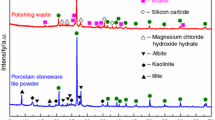One of the reasons for the comparatively low quality of dense ceramic materials (porcelain tiles, facade tiles, and floor tiles) resulting from the appearance of a black core is the presence in them of unburned carbonaceous particles remaining in the articles after firing because of poorly selected compositions and heat-treatment regime. Studies have shown that the highest weight content of C (carbon) with respect to other layers of porcelain stoneware is found in the black porous core (9.68%). The appearance of a black core is explained by the fact that in the heating process organic impurities are charred primarily in the inner layers of the porcelain tile which are isolated from the air oxygen. Moreover, the formation of the black core will also be promoted by sintering with the participation of a liquid phase, which will isolate from the air the not yet fully oxidized carbonaceous material.


Similar content being viewed by others
References
V. Z. Abdrakhimov, Ceramic Building Materials [in Russian], Samarsk. Gos. Arkhitekt.-stroit. Universitet, Samara (2010).
E. S. Abdrakhimova and V. Z. Abdrahimov, “Investigation ofcombustion processes occuring during firing of heat-insulating material made from industrial raw materials of non-ferrous metallurgy and power generation,” Zh. Prikl. Khim., 85(8), 1247 – 1252 (2012).
S. T. Suleimenov, Physico-Chemical Processes Involved in Structure Formation in Building Materials and Mineral Wastes of Industry [in Russian], Monuskript, Moscow (1996).
V. Z. Abdrakhimov, I. Yu. Roshchupkina, and E. S. Abdrakhimova, “Carbon combustion processes during firing of insulating material from waste oil shale,” Koks i Khim., No. 11, 35 – 41 (2012).
O. A. Esin and P. V. Geld, Physical Chemistry of Pyrometallurgical Processes. Part 1. Reactions between Gas and Solid Phases [in Russian], Metallurgiya, Sverdlovsk (1962).
V. P. Petrov and B. A. Maksimov, “Mechanism and kinetics ofcombustion of coal particles in granules of porous aggregates,” in: Current Status and Prospect of the Development of Building Materials Science: 8th Academic Lectures of RAASN [in Russian], SGASU, Samara (2004), pp. 407 – 410.
S. A. Tokarev and V. P. Petrov, “Kinetics of carbon combustionin granules during firing of clay expanded keramzit in rotary kilns,” Izv. Vyssh. Uchebn. Zaved., Stroitel’stvo, No. 5, 20 – 27 (2001).
V. F. Pavlov, Physicochemical Principles of Firing Building Ceramic Articles [in Russian], Stroiizdat, Moscow (1977).
V. F. Pavlov, “The role of iron oxide in the formation of thestructure of acid-resistant porcelain,” in: Proceedings of the Scientific-Research Institute of Building Ceramics: Scientific Research in the Field of Mechanization of Technological Processes and the Development of New Compositions of Bodies and Glazes [in Russian] (1982), pp. 48 – 56.
V. I. Dobuzhinskii, New Technology of Ceramic Tiles [in Russian], Stroiizdat, Moscow (1977).
Author information
Authors and Affiliations
Corresponding author
Additional information
Translated from Steklo i Keramika, No. 7, pp. 37 – 41, July, 2019.
Rights and permissions
About this article
Cite this article
Moshnyakov, M.G., Abdrakhimov, V.Z. Investigations of the Black Core and Swelling in Firing Porcelain Stoneware. Glass Ceram 76, 270–273 (2019). https://doi.org/10.1007/s10717-019-00181-8
Published:
Issue Date:
DOI: https://doi.org/10.1007/s10717-019-00181-8




